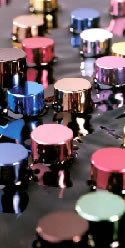Sulphuric Acid Anodising
Sulphuric acid anodising is the most common protective treatment commercially applied to aluminium. The process involves the controlled electro-chemical formation of an oxide layer to the aluminium surface which leaves a clear or ‘natural’ coloured finish. This oxide layer can be left either ‘natural’ or can be coloured by employing various dye stuffs. As anodising does not involve the coating of the aluminium with any other metal, or any man made coating, the process will not hide any surface imperfections or blemishes on the substrate surface.
As anodising is a process which requires electrical contact, there should always be an allowance made for small contact points which will be evident on the work after anodising, should specific jigging points be required, critical faces or bores, it is important we are informed of this prior to processing.

The process results in a coating thickness of between 5 and 25 microns dependant on customer requirements and components use. This thickness should be taken into account when machining components requiring tight tolerances. We are happy to assist with any tolerance advice.
Materials
Most alloys can be successfully anodized employing the sulphuric acid process however the most common alloys treated within Graph are the common commercially available alloys 6000 and 7000 series alloys. Due to the differing alloying elements in each series the finish can vary significantly and it is advisable to discuss your choice of alloy with us at the design stage of components. Should we not be involved in the design, it is important that we are informed of the alloy we receive as different alloys require different processing parameters such as 2000 series which has a high copper content and is susceptible to burning, we therefore need to adjust processing parameters to suit.
Maximium Size Criteria
Below is an indication of the maximum size of components which we can Sulphuric acid anodize.
| Dimension | Natural |
Black |
|---|---|---|
| Length mm | 1850 |
1850 |
| Width mm | 400 |
400 |
| Depth mm | 900 |
900 |
Dimensions for all other colours should be discussed as our dye baths vary in size.
Coating Thickness
The anodising process results in a coating thickness of between 5 and 25 microns with the thicker layers imparting greater corrosion protection. Colour work requires a minimum of 10 microns.
Sealing
There are a number of sealing techniques employed within the sulphuric anodising process, having carried out a series of trials on different products we have settled on the following methods.
* Cold Nickel Acetate Seal – This imparts greater corrosion resistance
* Hot De-Ionized water seal.
Colours
The colour options available in anodising are vast and should a specific colour be required we will do our utmost to match any sample. Our standard colour range is as follows:
* Gold |
 |
|---|---|
* Black |
|
* Blue |
|
* Bordeaux |
|
* Green |
|
* Fiery Red |
These colours are guide only and we would generally operate to a sample and provide upper and lower limits for optical colour to be signed off by both parties.